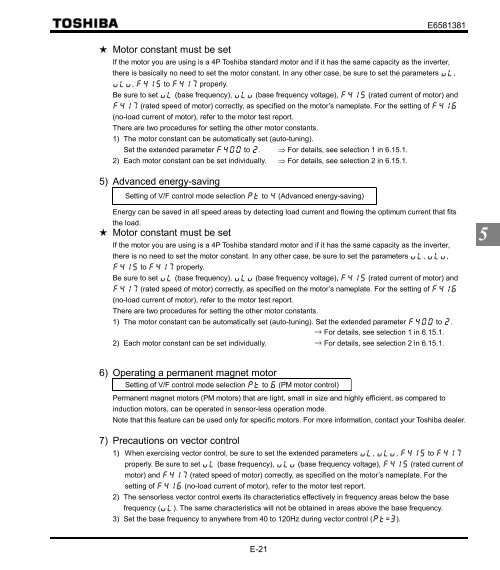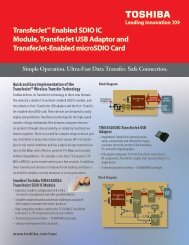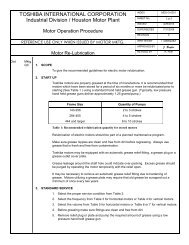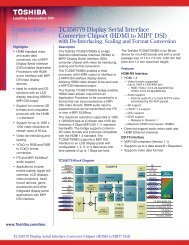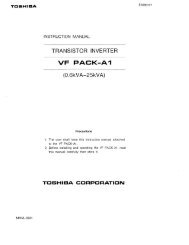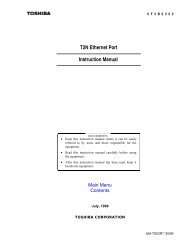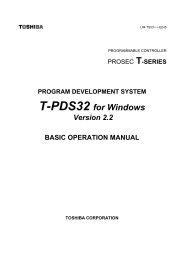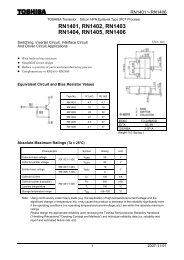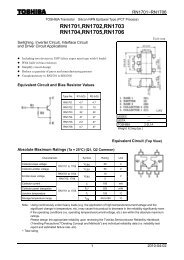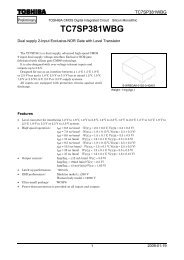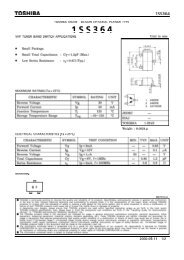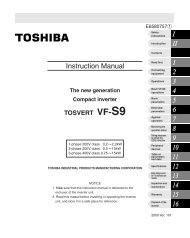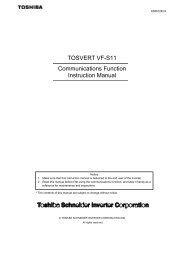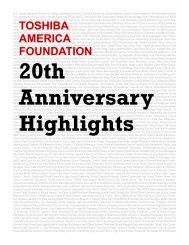VF-FS1 Industrial Inverter - Toshiba
VF-FS1 Industrial Inverter - Toshiba
VF-FS1 Industrial Inverter - Toshiba
Create successful ePaper yourself
Turn your PDF publications into a flip-book with our unique Google optimized e-Paper software.
Motor constant must be set<br />
E-21<br />
E6581381<br />
If the motor you are using is a 4P <strong>Toshiba</strong> standard motor and if it has the same capacity as the inverter,<br />
there is basically no need to set the motor constant. In any other case, be sure to set the parameters ,<br />
, to properly.<br />
Be sure to set (base frequency), (base frequency voltage), (rated current of motor) and<br />
(rated speed of motor) correctly, as specified on the motor’s nameplate. For the setting of <br />
(no-load current of motor), refer to the motor test report.<br />
There are two procedures for setting the other motor constants.<br />
1) The motor constant can be automatically set (auto-tuning).<br />
Set the extended parameter to . ⇒ For details, see selection 1 in 6.15.1.<br />
2) Each motor constant can be set individually. ⇒ For details, see selection 2 in 6.15.1.<br />
5) Advanced energy-saving<br />
Setting of V/F control mode selection to (Advanced energy-saving)<br />
Energy can be saved in all speed areas by detecting load current and flowing the optimum current that fits<br />
the load.<br />
Motor constant must be set<br />
If the motor you are using is a 4P <strong>Toshiba</strong> standard motor and if it has the same capacity as the inverter,<br />
there is no need to set the motor constant. In any other case, be sure to set the parameters , ,<br />
to properly.<br />
Be sure to set (base frequency), (base frequency voltage), (rated current of motor) and<br />
(rated speed of motor) correctly, as specified on the motor’s nameplate. For the setting of <br />
(no-load current of motor), refer to the motor test report.<br />
There are two procedures for setting the other motor constants.<br />
1) The motor constant can be automatically set (auto-tuning). Set the extended parameter to .<br />
⇒ For details, see selection 1 in 6.15.1.<br />
2) Each motor constant can be set individually. ⇒ For details, see selection 2 in 6.15.1.<br />
6) Operating a permanent magnet motor<br />
Setting of V/F control mode selection to (PM motor control)<br />
Permanent magnet motors (PM motors) that are light, small in size and highly efficient, as compared to<br />
induction motors, can be operated in sensor-less operation mode.<br />
Note that this feature can be used only for specific motors. For more information, contact your <strong>Toshiba</strong> dealer.<br />
7) Precautions on vector control<br />
1) When exercising vector control, be sure to set the extended parameters , , to <br />
properly. Be sure to set (base frequency), (base frequency voltage), (rated current of<br />
motor) and (rated speed of motor) correctly, as specified on the motor’s nameplate. For the<br />
setting of (no-load current of motor), refer to the motor test report.<br />
2) The sensorless vector control exerts its characteristics effectively in frequency areas below the base<br />
frequency (). The same characteristics will not be obtained in areas above the base frequency.<br />
3) Set the base frequency to anywhere from 40 to 120Hz during vector control (=).<br />
5


